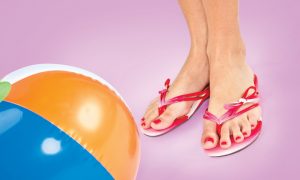Everyone looks forward to the Summer where they can shed their heavy shoes and go with lighter, airier styles. While Summer sandals and shoes are well ventilated and comfortable to wear in hot weather, not to mention super cute, did you know that they can also do serious damage to the bones and joints in your feet? Wearing the wrong footwear in the wrong conditions can lead to foot, knee and back issues and if you have existing foot issues such as plantar fasciitis, bunions or are diabetic, the Summer heat can make your condition worsen.
By taking the right steps, however, many foot health problems can be avoided or at least lessened, even during the dog days of Summer. Here are 3 easy ways to avoid foot injuries this summer.
Don’t Go Barefoot
During the Summer months it’s very tempting to go barefoot. That luscious green grass just looks like it would feel so soft and cool under your feet. That beach sand would feel silky smooth running through your toes. However, going barefoot is not without risks. In that green grass or sand may be a sharp object that isn’t noticeable to the eye. Aside from actual dangerous objects, walking barefoot also exposes your feet to sunburn on hot pavement or sand and bacterial infections such as plantar warts, athelete’s foot and ring worm. You might also have a condition called neuropathy without even knowing it. It’s a disease of the peripheral nerves that causes weakness or numbness in the feet and hands. If you burn or injure your feet you may not feel the pain until it’s gotten much worse.
Solution: It’s best to wear sandals that allow your feet to breathe but still protect them from unseen objects on the ground. Around the pool, locker room and your hotel room, even if it is carpeted, be sure to wear flip flops or shoes.
Forgo The Flip Flops
Summer is flip flop season. You see flip flops everywhere from the beach to the pool to in the city. Flip flops do have their use and place and are great to wear for short periods of time by the pool, in the locker room or on the beach as an alternative to going barefoot. However, they are not a good choice if you are going to be walking for longer periods of time or wearing them day in and day out.
It’s the flip-flop’s no-frills design that contributes to summer’s most common foot injury, Metatarsalgia. Metatarsalgia is a type of pain and inflammation that occurs in the metatarsal (ball of the foot). When you grip the toe piece on a flip flop your toes flex which causes the ball of your foot to drive into the ground. Left untreated, Metatarsalgia can result in stress fractures of the metatarsal joints and several weeks in a cast or worse, a complete bone fracture that requires surgery. Thin rubber flip flops have no arch support whatsoever and walking in flip flops forces you to change the biomechanical pattern of the way you walk. You begin to use muscles and joints in a different way and if you do so repetitively, you are setting yourself up for joint and muscle strains. Ankle sprains, stubbed or broken toes and falls are common when people try to run in flip flops.
Solution: If you enjoy the breeziness of a flip flop select one that features built-in orthotic support and a stiffer sole. Instead of allowing the foot to flatten and tilt inward, which can lead to an uncomfortable gait, pain and possibly injury, these are engineered to keep the foot, ankle and lower leg in proper alignment and pain-free. Also, try to wear these shoes in moderation and refrain from running in flip flops.
Support Your Flats
If you think flats are a great idea because they are comfortable and are the opposite of heels so they must be good for your feet, you are wrong. Like flip-flops, flats are floppy and unsupportive of your feet.
Frequent flat wearers also often suffer from Metatarsalgia as the ball of the foot and its adjacent joints receive a pounding with each step. If you have foot problems already, wearing flats can even aggravate your existing issues. People who need arch support in their shoe such as flat-footed people can get strains like plantar fasciitis or heel spur syndrome
Solution: Wear an orthotics support in your shoe. There are styles made from graphite that are as thin as a credit card so they are inconspicuous when you wear them

